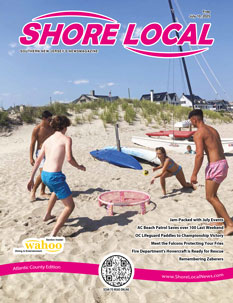By Mari D’Albora Dattolo
Col. John McKee, known in his day as “the wealthiest man of color in America,” developed McKee City in Hamilton and Egg Harbor townships, not long after his Union Army service in the Civil War. McKee was both a Civil War veteran and visionary in the development of South Jersey communities.
Born in Virginia in 1821 to freed former slaves, he moved to Philadelphia at the age of 21 where he married Emeline Prosser, the daughter of a successful Market Street restaurateur for whom he had worked for more than 10 years. In 1863 he enlisted in the 12th Regiment of the U.S. Colored Infantry of the Pennsylvania National Guard. He was promoted to lieutenant colonel of the 13th Regiment, serving under Gen. Louis Wagner.
Following the war in 1866, Col. McKee became involved in real estate in Philadelphia, marketing land parcels, and leasing housing to freed slaves who were looking to resettle in Northern states. The colonel’s 1884 McKee City plan was originally for a farming community for freed slaves complete with a sawmill, a schoolhouse, a general store, a community hall and several farms near the former West Jersey Atlantic Railroad. His simple, dormitory-style frame homes were without plumbing or heating.
In a similar scheme in South Jersey, Union Gen. Gano Burbridge, a decorated Civil War veteran from Kentucky, planned a community for a location 3 miles south of Mays Landing in a colony named Estellville for Russian Jews. For $600, each Russian family was given a two-room cottage, 15-acre lot for farming, tools, farm animals, seeds and furniture. It, too, was a failed attempt to survive the South Jersey winters and poor quality sandy soil.

By 1870, McKee’s real estate holdings had grown to $190,000. His vast land holdings included 4,000 acres in Atlantic County, 400 properties in Philadelphia, 66 acres along the Delaware River, 23,000 acres in New York, and some 300,000 acres of coal, oil and farmland holdings in Georgia, Kentucky and West Virginia. By today’s standards, his financial worth would be roughly $52 million.
In his 27-page will, Col. McKee stated that his intent was to continue the development of McKee City. Additionally, he set aside 10 acres of land for the Roman Catholic Church, on which would be built St. Katharine Drexel Parish in Egg Harbor Township 100 years later.
He named Archbishop Patrick Ryan of Philadelphia as executor of his estate as a tribute to the care he received from nuns when he contracted typhoid fever in 1896. He appreciated the kindness displayed by Catholic nuns to people of color suffering from the disease, as opposed to what he received from other white caregivers who would often avoid ministering first aid. A second executor was Joseph P. McCullen, later a judge of the Philadelphia courts, who had been McKee’s legal adviser throughout his adult years.
In an attempt to ensure his legacy, McKee stipulated that a naval academy for orphaned young men be built on the Delaware River, prominently featuring a bronze statue of him on horseback. He included in his 1899 will a photo of himself in his Civil War uniform. Due to legal wrangling, neither of these two directives came to fruition.
To the surprise of his own family, McKee was considerably less generous with his daughter and grandchildren than he was with his intended academy.
To his daughter, with whom he lived, he left a cottage and a $300 annuity. To Henry McKee Minton, a grandson by his deceased daughter, Jennie, he bequeathed a watch with an annuity of $50. Grandsons from his living daughter Abbie named Theophilus, Douglas, Marcellus, Ernest and John McKee Syphax, were bequeathed annuities of $50 per year each. Following the death of their mother, McKee’s great grandchildren disputed the will in 1952, however their claims were dismissed.
One of the colonel’s goals was to establish his namesake institution, “Colonel John McKee College,” to be built only after all of his children and grandchildren had died. In his vision for the future, he wanted to give the world a lasting memorial to himself so he would be “remembered for as long as the world stands.”
He left instructions that the curriculum should follow the same naval education as provided at the Naval Academy in Annapolis, Md. At the entrance to his college, visitors should be greeted by a bronze statue of McKee, identical in style to the statue of Gen. John F. Hartrantt in City Hall Plaza in Philadelphia with the inscription, “Colonel John McKee, Founder of this College.” And finally, on Decoration Day and Founder’s Day, students were to parade and decorate the statue with flowers.
The colonel left detailed funeral plans in the will. The first directive stipulated that services for the colonel should be conducted at the Cathedral Basilica of Saints Peter and Paul in Philadelphia, including the celebration of a Requiem Mass. This did not occur because the will was not read until after he was given a Presbyterian funeral at the Central Presbyterian Church in Philadelphia, with burial at the Eden Cemetery in Collingdale, Pa., a few miles outside of the city. It was later determined that his funeral could not have been observed in the cathedral anyway, nor his remains buried in hallowed ground because he had not been baptized in the Catholic faith.
The will instructed that 25 carriages were to be hired to take mourners to the funeral services. He specified that his coffin should be black walnut and that his remains should be placed in a vault below ground with a 12-foot-high, granite monument above ground. It is doubtful that 25 carriages were needed for the amount of mourners that attended.
McKee instructed that accounting reports of his estate be published in two newspapers annually in perpetuity.
Today this South Jersey community retains the reference “McKee City,” but few signs of his anticipated empire remain.
He brought in the West Jersey Railroad with a small station in 1880 at English Creek (Egg Harbor Township). At the same time, Mays Landing’s city-to-shore route was established. In August 1966 the service was formally abandoned.
In 2000, the long-awaited Catholic church was erected at 6077 West Jersey Ave. in Egg Harbor Township as his lasting legacy of McKee City. It was named for St. Katharine Drexel, the patron saint of racial justice and philanthropists. St. Katharine is buried in the Cathedral Basilica of Saints Peter and Paul in Philadelphia.
Although McKee was heralded as the wealthiest man of color of his time, he took advantage of uneducated freed slaves, trading cheap housing opportunities for their post-war-issued property titles and rents, and transferring the power of land ownership from the plantations to himself.
Recognizing that he had contributed to the victimization of his own people – including his own family – history does not look kindly upon him. A newspaper report on his death in 1902 described him as “a man absolutely devoid of sentiment. He viewed life and individuals from only one standpoint and that was what they were worth to him.”
Today little remains of McKee City. Many of the original buildings burned or were torn down. Part of the land holdings became what was the former Atlantic City Race Course and the Hamilton Mall.
Bill Boerner owns the last remaining farmhouse from McKee City, which his family purchased nearly a century ago. He still grows apples and other produce on his Pleasant Valley Farms property off of Route 40 in Hamilton Township.
Col. McKee died on April 6, 1902, of a paralytic stroke at the age of 81. His legacy continues to fund an estimated 20, $250,000 scholarships yearly for orphaned young men from Philadelphia area institutions.
For further information on Col. John McKee see Newspapers.com or the Atlantic County Library, Mays Landing Branch.














